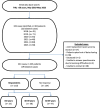Satisfaction rates, function, and return to activity following young adult total hip arthroplasty
- PMID: 38616049
- PMCID: PMC11016360
- DOI: 10.1302/2633-1462.54.BJO-2024-0005.R1
Satisfaction rates, function, and return to activity following young adult total hip arthroplasty
Abstract
Aims: Young adults undergoing total hip arthroplasty (THA) largely have different indications for surgery, preoperative function, and postoperative goals compared to a standard patient group. The aim of our study was to describe young adult THA preoperative function and quality of life, and to assess postoperative satisfaction and compare this with functional outcome measures.
Methods: A retrospective cohort analysis of young adults (aged < 50 years) undergoing THA between May 2018 and May 2023 in a single tertiary centre was undertaken. Median follow-up was 31 months (12 to 61). Oxford Hip Score (OHS) and focus group-designed questionnaires were distributed. Searches identified 244 cases in 225 patients. Those aged aged under 30 years represented 22.7% of the cohort. Developmental dysplasia of the hip (50; 45.5%) and Perthes' disease (15; 13.6%) were the commonest indications for THA.
Results: Preoperatively, of 110 patients, 19 (17.2%) were unable to work before THA, 57 (52%) required opioid analgesia, 51 (46.4%) were reliant upon walking aids, and 70 (63.6%) had sexual activity limited by their pathology. One patient required revision due to instability. Mean OHS was 39 (9 to 48). There was a significant difference between the OHS of cases where THA met expectation, compared with the OHS when it did not (satisfied: 86 (78.2%), OHS: 41.2 (36.1%) vs non-satisfied: 24 (21%), OHS: 31.6; p ≤ 0.001). Only one of the 83 patients (75.5%) who returned to premorbid levels of activity did so after 12 months.
Conclusion: Satisfaction rates of THA in young adults is high, albeit lower than commonly quoted figures. Young adults awaiting THA have poor function with high requirements for mobility aids, analgesia, and difficulties in working and undertaking leisure activities. The OHS provided a useful insight into patient function and was predictive of satisfaction rates, although it did not address the specific demands of young adults undertaking THA. Function at one year postoperatively is a good indication of overall outcomes.
© 2024 Galloway et al.
Conflict of interest statement
J. Skinner discloses being an editorial board member of The Bone & Joint Journal, which is unrelated to this work. All other authors have no disclosures or conflicts of interest to declare.
Figures
References
-
- Varacallo M, Luo TD, Johanson NA. Total hip athroplasty techniques In StatPearls Publishing Treasure Island (FL) 2023. - PubMed
-
- No authors listed Age of patients undergoing primary hip replacement. National Joint Registry. 2023. [2 April 2024]. https://reports.njrcentre.org.uk/hips-primary-procedures-patient-charact... date last. accessed.
-
- No authors listed Patient chacteristics for primary hip replacement procedures. National Joint Registry. 2023. [2 April 2024]. https://reports.njrcentre.org.uk/hips-primary-procedures-patient-charact... date last. accessed.
-
- Christofilopoulos P, Lübbeke A, Peter R, Hoffmeyer P. Le point sur la prothèse totale de hanche [Published in French] Rev Med Suisse. 2010;6(276):2454–2458. - PubMed
LinkOut - more resources
Full Text Sources
Miscellaneous


